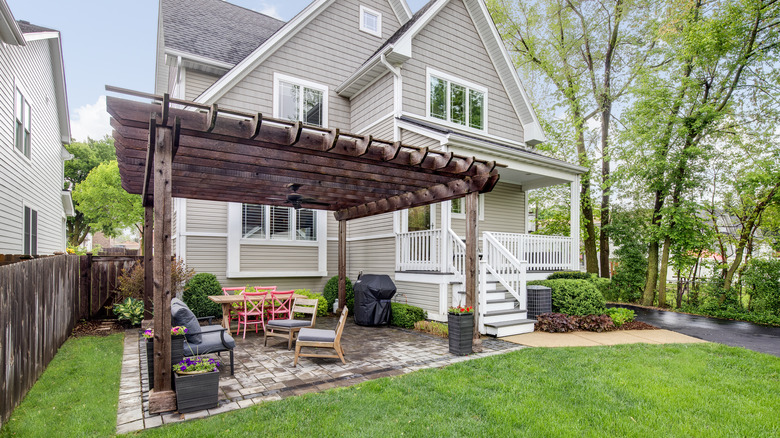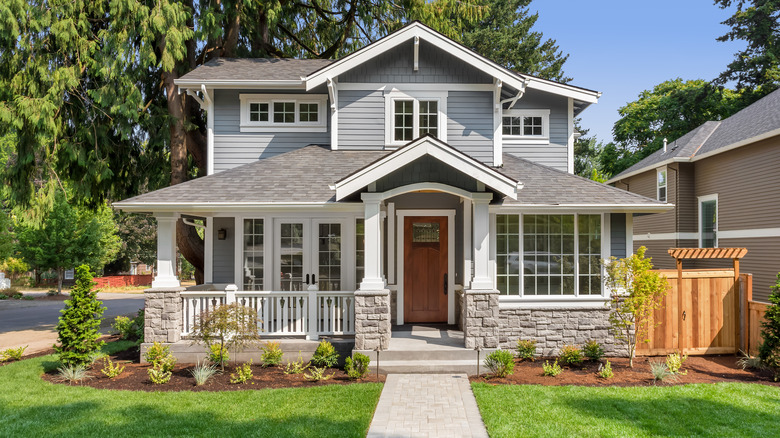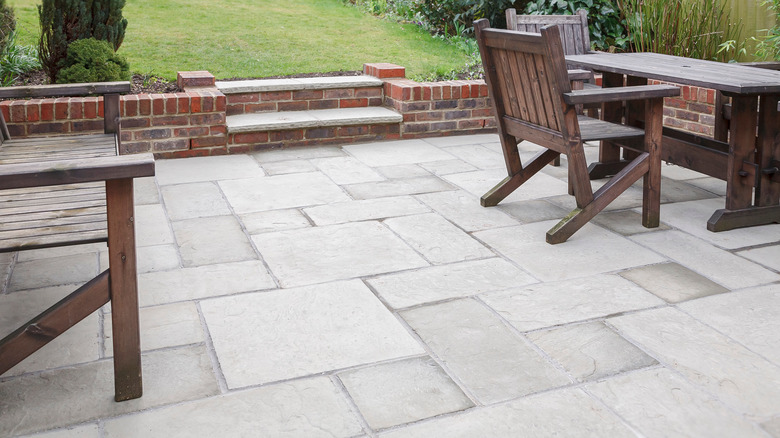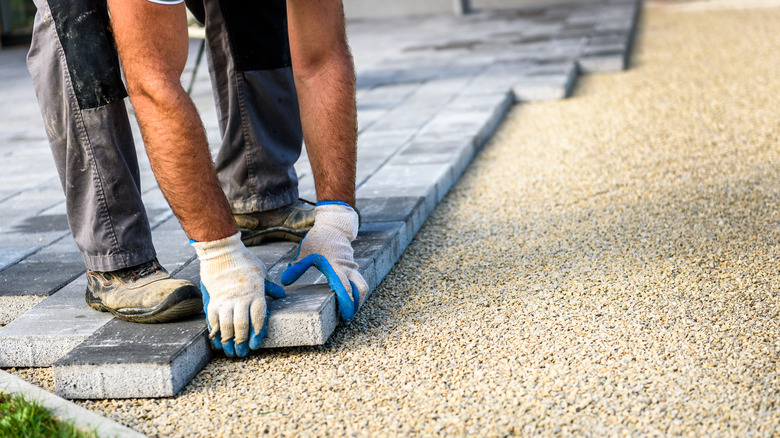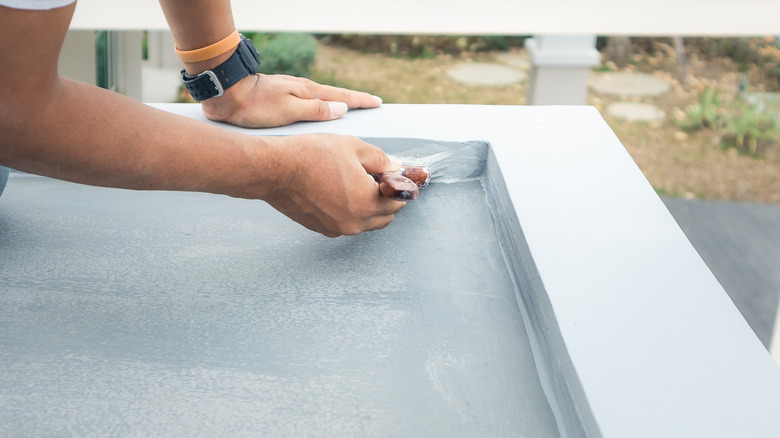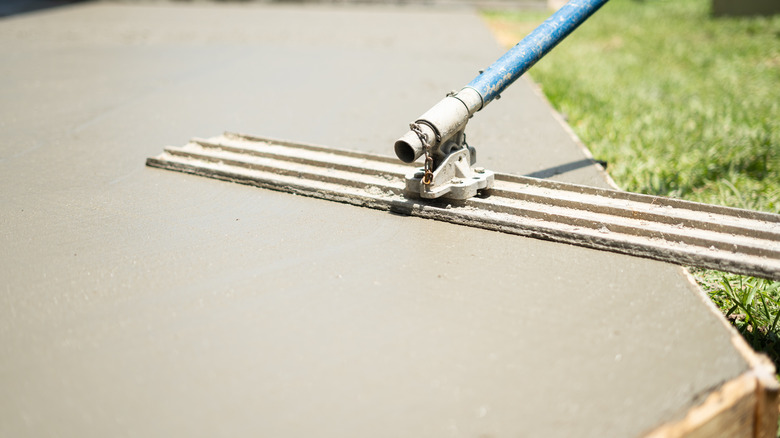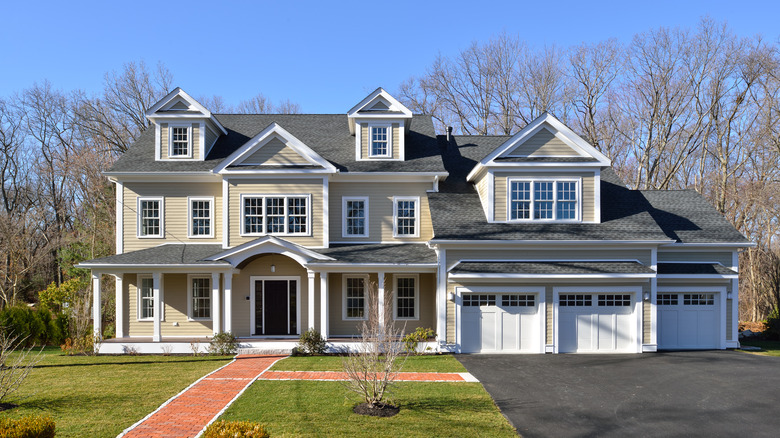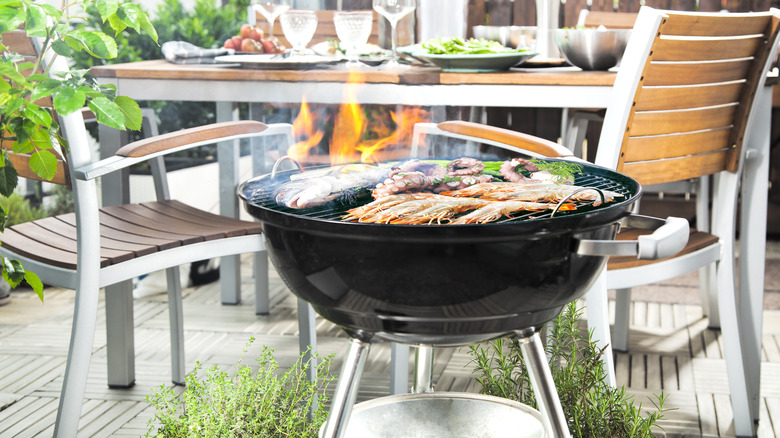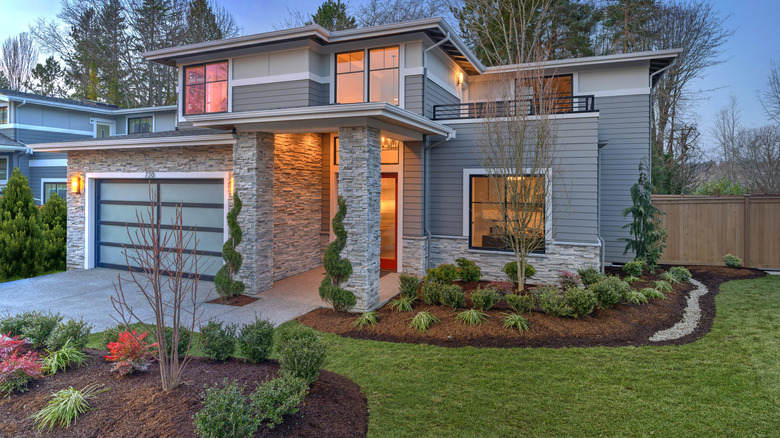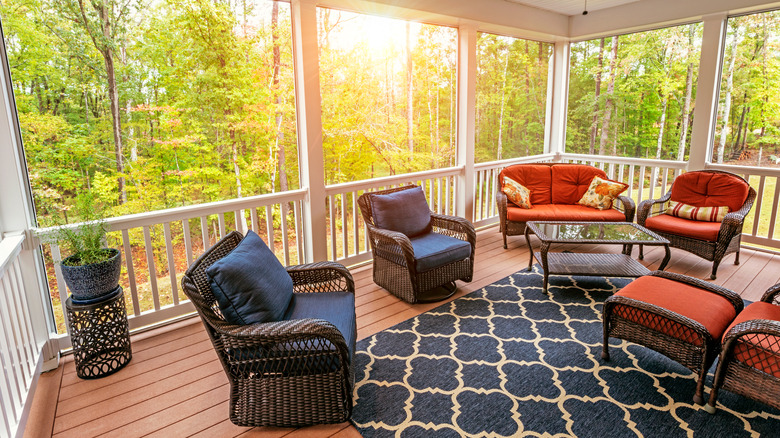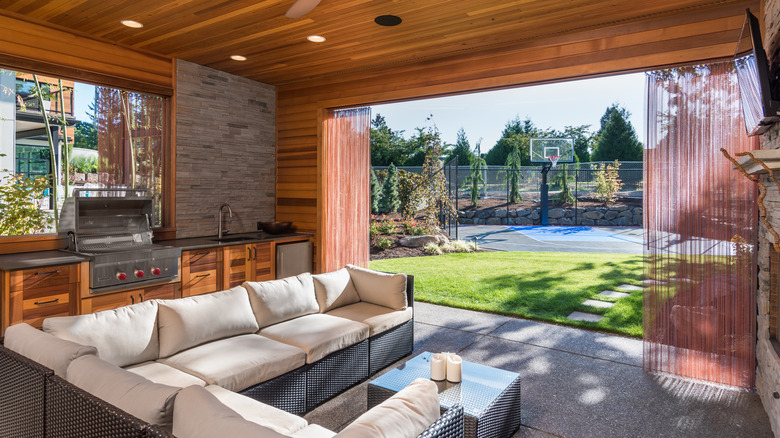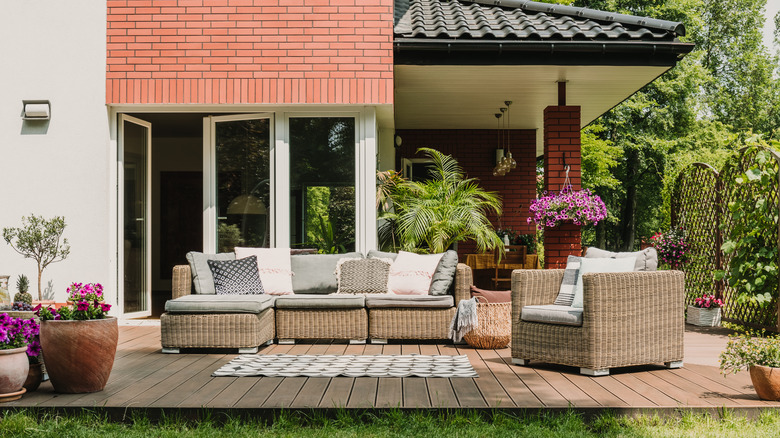Porches Vs. Patios: A Comparison
If the warmer weather gets you thinking about being outside, that's a good thing. According to the USDA, studies show that being out in nature reduces our stress levels along with our cortisol levels, relieves muscle tension, and is just all-around relaxing. Go ahead and get outside. It's helpful when your home is designed with a comfortable outdoor living space, so you don't have to leave every time you want to enjoy some sunshine and fresh air.
Porches and patios are two of the most popular ways to make that happen. But which one is best for you and your family? In this article, we'll look at some differences between porches and patios, so you'll be better equipped when you're trying to decide on the best way to create an outdoor oasis at home. No matter what you choose, the addition of an outdoor seating area will improve your home life and aid in building beautiful memories for years to come.
What's a porch?
There are four types of porches: wraparound, screened, front, and back. According to Merriam-Webster, a porch is a covered area adjoining an entrance to a building and usually has a separate roof. That's a formal definition, but having a porch is just the opposite of formal. Porches bring a welcoming, relaxed feeling to a home, especially a front porch. They came to us around the middle of the 19th century, according to MLive. Then and still today, the porch is the place where friends and families gather and lazy summer days are enjoyed. If being covered while outside is important to you, then a porch is an excellent option.
They not only allow homeowners to stay under cover while sitting outside, but they also add a charming aesthetic to a home since they are truly an architectural structure and an extension of a house. It creates a place to add beauty to your home as you decorate it for each season. A porch offers additional seating when you have guests and is a friendly way to greet your neighbors as they walk by. Best of all, your front porch is the perfect escape when you need a break.
What's a patio?
According to Merriam-Webster, a patio is a recreation area that adjoins a dwelling, is often paved, and is adapted especially to outdoor dining. Sounds like somewhere we'd all like to hang out on a Saturday night. The patio is a great solution for a simple seating area or outdoor living room.
Fill it with chairs, a table, and even an outdoor cooking area. They're most often only useful in warmer seasons but a patio can also be covered, making it more comfortable during the cooler months and also offering shade on hot days. They're also a safe choice when uncovered for fire pits and grilling, helping you stretch out the season. A benefit of patios is that you don't have to worry so much about the size of your house and whether it will fit since they aren't directly attached to your home as a structure. Make your patio as small or big as you need and choose from a wide variety of materials.
Materials used for a porch and patio
Patios are most often made of concrete and there's good reason for that. According to Schumacher Homes, concrete is neutral, so most furniture goes well with it, and it's also one of the most affordable options available, with little need for maintenance. Other common materials used are brick, flagstone, or pavers. Other than that, you don't need much except the ability to pour a concrete slab and the right tools, such as a sod cutter to remove grass before laying down brick, flagstone, or pavers.
Porches, however, are more complicated, using decking materials, such as wood or wood composite, posts, railing systems, joist hangers, moisture barrier, screws, and often, concrete. Porches require more material because they're an extension of your home and an actual structure. They need to match the house and be just as strong. They may also include electrical work, such as lighting, outlets, and a ceiling fan. Porches need roofing material and sometimes, painting. Concrete floors are common but as mentioned, so is decking material. Sometimes wood planks are used and painted for a porch floor. Because porches can have many designs, the possibilities are endless for style and materials.
The difference in cost
Which costs more – patio or porch? Unless it's very elaborate, a patio will often be less expensive to install than a porch. They're commonly just a poured slab of concrete, while a porch is an architectural structure. According to Gardeningetc, one way to save even more on a patio's materials is by using reclaimed brick. You'll have a cottage-style or rustic look while using resources responsibly.
The average cost for a 16x12 patio ranges from $2,000-$4,000, while the average for a 16x20 porch is $16,000-$30,400, according to Fixr. That's quite a difference and nothing to be taken lightly. If you're on tight budget, clearly, a patio is the way to go. Porches are great — they just require a lot more planning, materials, and labor. Still, if you know a porch is what's best for your home, it might be worth the extra time it takes to save up for what suits your family best.
Durability and maintenance
Both a porch and a patio are durable, but a porch may require more maintenance over time, especially if painting is involved. According to Handyman Connection, porches require the removal of standing water after a storm, staining or painting the floor when necessary, and updating railing systems and flooring when needed. A porch may have other extra needs, such as touching up the paint on posts and cleaning ceiling fans and light fixtures.
Patios aren't without maintenance. When using pavers or bricks, grass and weeds like to try to grow between the cracks and must be removed. Brick and other pavers can become wobbly over time and need to be replaced or leveled out. A pressure washer is a great tool to clean your patio once or twice a year. Sometimes concrete cracks and needs to be repaired or replaced. Regular maintenance is the best way to keep both a porch and a patio working well for your home.
Ease of installation
There are a lot of factors to consider when determining how easy or difficult it may be to install a patio or porch. More often than not though, a patio is an easier installation. According to TCP Custom Outdoor Living, a porch can take anywhere from three to 16 weeks to construct. A patio is usually finished in a day. So, if time is of the essence, choose the patio.
Porches are a building project, requiring plans, a contractor, lots of materials, and of course, money. There may be deconstruction as well before the new porch is attached if an old one needs to be removed. Many homeowners can lay a patio themselves when designing it with brick, flagstone, or other pavers. Those items are found at home improvement stores. For a concrete patio, all it takes is preparing the space and coordinating with a concrete company to simply have the concrete poured. The verdict is in: A patio is easier to install. Still, if a porch is the better choice for your home, it's worth the extra time, cost, and labor.
How big can you get?
Are you looking for a go big or go home place to sit outside, or something simple and subtle? The size of your home and yard is the place to start when choosing how big your porch or patio should be. According to Concrete Network, common sizes for patios are small (7ftx7ft), medium (12ftx14ft), and large (16ftx18ft). To visualize each size, keep in mind that a small patio is suitable for a small table and two chairs (bistro style). A medium patio is made for the most common outdoor dining tables you see at your neighbor's house with six to eight chairs around it. The large patio is for those who want a comfortable seating area outside with lounge chairs, a couch, and a coffee table.
When looking at porches, your home determines how big you can design it. Ranch homes look great with a low, long porch all the way across the front. A farmhouse or Victorian-style home beckons for the wraparound. Front entry porches are the smallest option and can make a big impact at the front door. Work with your designer or contractor to determine what will look and fit best.
Increased property value
We all want to increase our home's value when taking on a home improvement project. Thankfully, both a porch and a patio can only benefit that value. According to SuperMoney, patios often offer around an 80% return on investment when the patio itself cost is anywhere from $2,000 to $4,000. That's a significant ROI when selling your home. Discover tells us that porches increase a home's value sometimes up to 84%. Clearly, a patio or a porch are both wise choices when considering property value.
Still, what if you aren't planning on moving anytime soon? If that's the case, you can still add a porch or patio for the sake of your family's enjoyment. Keep in mind, however, that your property taxes may go up during an assessment after you've made an addition to your home. In the end, it's your home, and although improvements can raise your taxes a bit, they're usually worth it for a happy and comfortable lifestyle and increased property value.
Which one is more useable?
When trying to decide between a porch and a patio, consider your lifestyle. Are you more likely to grill out all summer long, or sit and relax on a wicker couch with a glass of lemonade? If you're more interested in the chilling out method and some quiet time, you may prefer a porch. Porches are always shaded because they're covered. They're perfect for creating comfortable seating areas, and with other luxuries, such as a ceiling fan, you can literally sit there all day.
Patios are perfect for homeowners who love to eat outside and often have gatherings with friends. A patio is usually an extension of the backyard so when there's a spillover of people it's not a big deal. You can add some chairs to the lawn. For the master griller, it's the obvious choice. According to Captain Patio, a covered porch is unsafe for grilling, due to poor ventilation and grease fires. Even with the most careful cook, you can stain your porch ceiling from the grease and smoke. The risk of fire hazards just isn't worth it.
The appearance
Although you may prefer sitting on one or the other, which will look better on your home : A porch or a patio? Some homes seem to naturally need a porch, while others don't look right with one. On the other hand, if your yard is almost non-existent, a patio may not make any sense.
According to Clever Patio, most homes today have replaced the porch concept with sunrooms and front decks. The front porch used to be an iconic symbol of a friendly neighborhood, but modern homes aren't often built with them anymore. If you want your home to have a unique style that's reminiscent of days gone by, a front porch will give you that appearance. Porches are charming and welcoming. For a contemporary home or a minimalist design, you won't get the sleek-lined sophistication you desire, with a porch. In that case, a smooth, squared patio may suit your style best and go well with the home.
Flexibility is key
Do you like options? Both patios and porches be changed through the years to accommodate your family. Patios can convert to covered patios and porches can become screened-in or even a sunroom. According to PA Sunrooms, you can convert a screened-in porch into a sunroom by replacing the screens with durable glass. Doing so brings temperature control, noise reduction, furniture protection, and an increase in home value.
Patios are easy to expand as needs change, and materials can be switched out as your style and choice of design change through the years. You may start with a simple, poured concrete slab, and years later decide to change the patio into a more decorative spot, using brick or flagstone. Patios offer great flexibility in their purpose. Use it all summer for grilling your best BBQ and then continue enjoying it through the colder months with a portable fire pit, blankets, and s'mores
Where do you live?
The climate you live in, as well as your neighborhood, could help tip the scales when trying to choose between a porch and a patio. High humidity, along with swarms of mosquitos might make a screened-in option worth the investment, instead of something that's open. Just the opposite, colder climates may not get much use out of either a porch or a patio. That doesn't mean you should forgo either one. Just consider the seasons and use them to help make the right choice for your home.
Patios can enjoy some warmth with a portable or built-in firepit, an awning, or a permanent cover. According to Beside the Front Door, there are several ways to stay warm on a porch as well during the colder months. They suggest using a portable heater, an outdoor fireplace, a ceiling fan rotating in the proper direction to encourage warmth, or adding drop-down panels or curtains to help block the wind. And of course, a warm cup of hot cocoa never hurts.
Best of both worlds
If you have enough space and room in the budget, then maybe you'd be happiest with both a porch and a patio? They both serve similar, yet different purposes and only increase seating and entertaining options for your home. A big difference between the porch and the patio is that porches, especially in the front of the house, add curb appeal. You may build a front porch and never use it but as you drive by the front of your house, you'll never regret how beautiful it looks. Patios are most often in the backyard, so when they're put in, they should serve the purpose of being used.
If you can put both to use, that's even better. Still, if you can't decide based on whether or not the porch will get some use, that may not be an issue. In the end, it may be the restrictions of your city or HOA that make the decision for you. According to Smart Remodeling, some areas have restrictions as to how you use, maintain, or modify porches and patios. Check with your local city or homeowners association to see what they allow.
Do a privacy check
If you're a private person, then a patio in your backyard might suit you better than a front porch where all your neighbors know your business. However, if the view from a porch is outstanding, compared to a ground-level patio, you'll benefit from a built-up porch. An even better option is to build what you want and if privacy is an issue, take some steps to increase it. MyMove suggests growing some hedges around the patio, hanging drapes that can open and close on the porch or around a covered patio, and training climbing plants on a trellis or a pergola.
With a little creativity, you can make any place private and still enjoy your outdoor seating area. Spend some time sitting near or in the area in which you are considering your new addition to the home. Get a feel for how it might be to hang out there. You may find you like seeing all your neighbors walk by or you also may find it's time for a privacy fence.
